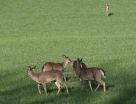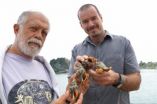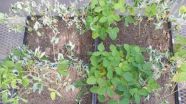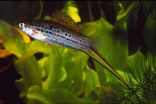(Press-News.org) WEST LAFAYETTE, Ind. - Regulated deer hunts in Indiana state parks have helped restore the health of forests suffering from decades of damage caused by overabundant populations of white-tailed deer, a Purdue study shows.
A research team led by Michael Jenkins, associate professor of forest ecology, found that a 17-year-long Indiana Department of Natural Resources policy of organizing hunts in state parks has successfully spurred the regrowth of native tree seedlings, herbs and wildflowers rendered scarce by browsing deer.
Jenkins said that while hunting may be unpopular with some, it is an effective means of promoting the growth and richness of Indiana's natural areas.
"We can't put nature in a glass dome and think it's going to regulate itself," he said. "Because our actions have made the natural world the way it is, we have an obligation to practice stewardship to maintain ecological balance."
Indiana state parks historically did not allow hunting. But by the 1990s, white-tailed deer populations in parks had swelled to such size that many species of native wildflowers such as trillium and lilies largely disappeared, replaced by wild ginger and exotic species such as garlic mustard and Japanese stiltgrass, plants not favored by deer. Oak and ash tree seedlings gave way to highly deer-resistant or unpalatable trees such as pawpaw.
The health of deer in state parks also dwindled as their food sources shrank.
To check the overabundant deer populations, the DNR introduced controlled hunts in state parks in 1993, with most parks adopting the strategy by 1996.
"Hunting in natural areas is controversial," Jenkins said. "But when deer are overabundant, they start to have undeniable negative impacts on the ecosystem."
Working with Christopher Webster, a Michigan Tech University professor and Purdue alumnus, Jenkins and then-master's student Lindsay Jenkins (no relation) tested the effectiveness of the hunting program by comparing the amount of plant cover in 108 plots in state parks and historically hunted areas with 1996-97 levels. They found that total plant cover in state parks more than doubled from 1996-97 to 2010. Herbs such as asters, violets and goldenrods increased from about 20 percent to 32 percent cover, and percent cover of grasses rose from 1 to 3 percent. Tree seedlings jumped from about 2 percent to about 13 percent of total plant cover, a finding that suggests when older trees die out, there will be younger trees to replace them, Jenkins said.
"With heavy populations of deer, tree seedlings often don't have a chance to survive," he said. "In those situations, the forest could lose its ability to reproduce itself and eventually cease to be healthy."
The study also showed that the hunting program led to the recovery of native species and discouraged the spread of invasive and exotic species, said Lindsay Jenkins.
"We saw a striking improvement in the quality and diversity of the forest understory in state parks compared with conditions before the hunting program," she said. "The deer management program is having a clear, beneficial impact on Indiana parks and could serve as a good example for nature preserves with overabundant deer in other states."
INFORMATION:
The study was published in Biological Conservation and is available at http://www.sciencedirect.com/science/article/pii/S0006320714001736.
Purdue's Department of Forestry and Natural Resources' John S. Wright Endowment provided funding for the research.
Hunting gives deer-damaged forests in state parks a shot at recovery
2014-07-09
ELSE PRESS RELEASES FROM THIS DATE:
Protein pushes breast cancer cells to metastasize
2014-07-09
Using an innovative tool that captures heretofore hidden ways that cells are regulated, scientists at Rockefeller University have identified a protein that makes breast cancer cells more likely to metastasize.
What's more, the protein appears to trigger cancer's spread in part by blocking two other proteins that are normally linked to neurodegeneration, a finding that suggests these two disease processes could have unexpected ties.
The study, which appears in the July 10 issue of Nature, points to the possibility of new cancer therapies that target this "master regulator" ...
Not at home on the range
2014-07-09
As climate change shifts the geographic ranges in which animals can be found, concern mounts over the effect it has on their parasites. Does an increased range for a host mean new territory for its parasites as well?
Not necessarily, says a team of UC Santa Barbara scientists, including parasitologists Ryan Hechinger and Armand Kuris. In a study published in the Journal of Biogeography, Hechinger, Kuris and colleagues show that for some species, the opposite may happen: Hosts may actually lose their parasites when the hosts shift or increase their range. Theirs is one ...
New system would give individuals more control over shared digital data
2014-07-09
Cellphone metadata has been in the news quite a bit lately, but the National Security Agency isn't the only organization that collects information about people's online behavior. Newly downloaded cellphone apps routinely ask to access your location information, your address book, or other apps, and of course, websites like Amazon or Netflix track your browsing history in the interest of making personalized recommendations.
At the same time, a host of recent studies have demonstrated that it's shockingly easy to identify unnamed individuals in supposedly "anonymized" data ...
NASA, NOAA satellites help confirm Tropical Storm Fausto as a remnant low
2014-07-09
NOAA's GOES-West and NASA-JAXA's Global Precipitation Measurement or GPM mission satellite helped forecasters at the National Hurricane Center determine that what was once Tropical Storm Fausto is now a remnant area of low pressure in the Eastern Pacific Ocean.
Forecaster Beven at the National Hurricane Center (NHC) noted that "satellite imagery, overnight scatterometer data, and a recent GPM satellite microwave overpass indicate that Fausto has degenerated to a trough of low pressure."
On July 9 at 1500 UTC (11 a.m. EDT) Fausto's circulation was no longer apparent ...
Study identifies novel genomic changes in the most common type of lung cancer
2014-07-09
Researchers from The Cancer Genome Atlas (TCGA) Research Network have identified novel mutations in a well-known cancer-causing pathway in lung adenocarcinoma, the most common subtype of lung cancer. Knowledge of these genomic changes may expand the number of possible therapeutic targets for this disease and potentially identify a greater number of patients with treatable mutations because many potent cancer drugs that target these mutations already exist.
TCGA is jointly funded and managed by the National Cancer Institute (NCI) and the National Human Genome Research ...
Study cracks how the brain processes emotions
2014-07-09
ITHACA, N.Y. – Although feelings are personal and subjective, the human brain turns them into a standard code that objectively represents emotions across different senses, situations and even people, reports a new study by Cornell University neuroscientist Adam Anderson.
"We discovered that fine-grained patterns of neural activity within the orbitofrontal cortex, an area of the brain associated with emotional processing, act as a neural code which captures an individual's subjective feeling," says Anderson, associate professor of human development in Cornell's College ...
Bacteria hijack plentiful iron supply source to flourish
2014-07-09
In an era of increasing concern about the prevalence of antibiotic-resistant illness, Case Western Reserve researchers have identified a promising new pathway to disabling disease: blocking bacteria's access to iron in the body.
The scientists showed how bacterial siderophore, a small molecule, captures iron from two abundant supply sources to fan bacterial growth — as well as how the body launches a chemical counterassault against this infection process. Their findings appear in a recent edition of The Journal of Experimental Medicine.
"Bacterial siderophore will be ...
Climate change provides good growing conditions for charcoal rot in soybeans
2014-07-09
URBANA, Ill. – With over 100 diseases that can attack soybean crops, why would charcoal rot rise to the top of the most wanted list? University of Illinois scientists cite the earth's changing climate as one reason that more research is needed on the fungus that causes charcoal rot.
Fungi may often be associated with cool, damp growing conditions but Macrophomina phaseolina, the fungus that causes charcoal rot, prefers hot and dry drought conditions.
"As the climate continues to change and we see more extremes in the weather, including hotter, drier summers, this fungus ...
Biologists link sexual selection and placenta formation
2014-07-09
RIVERSIDE, Calif. — Sexual selection refers to species' selection for traits that are attractive to the opposite sex. This special type of natural selection enhances opportunities to mate, the tail of male peacocks being an iconic example.
Biologists at the University of California, Riverside have now found that sexual selection and "placentation" — the formation of a placenta — are linked. Describing the life histories of more than 150 species of fish in the family Poeciliidae, the researchers found that species with placentas tend to have males that do not have bright ...
USF study: Amphibians can acquire resistance to deadly fungus
2014-07-09
Tampa, Fla. (July 9, 2014) – Emerging fungal pathogens pose a greater threat to biodiversity than any other parasitic group, causing population declines of amphibians, bats, corals, bees and snakes. New research from the University of South Florida published in the prestigious journal Nature reveals that amphibians can acquire behavioral or immunological resistance to a deadly chytrid fungus implicated in global amphibian population declines.
"Acquired resistance is important because it is the basis of vaccination campaigns based on 'herd immunity', where immunization ...






